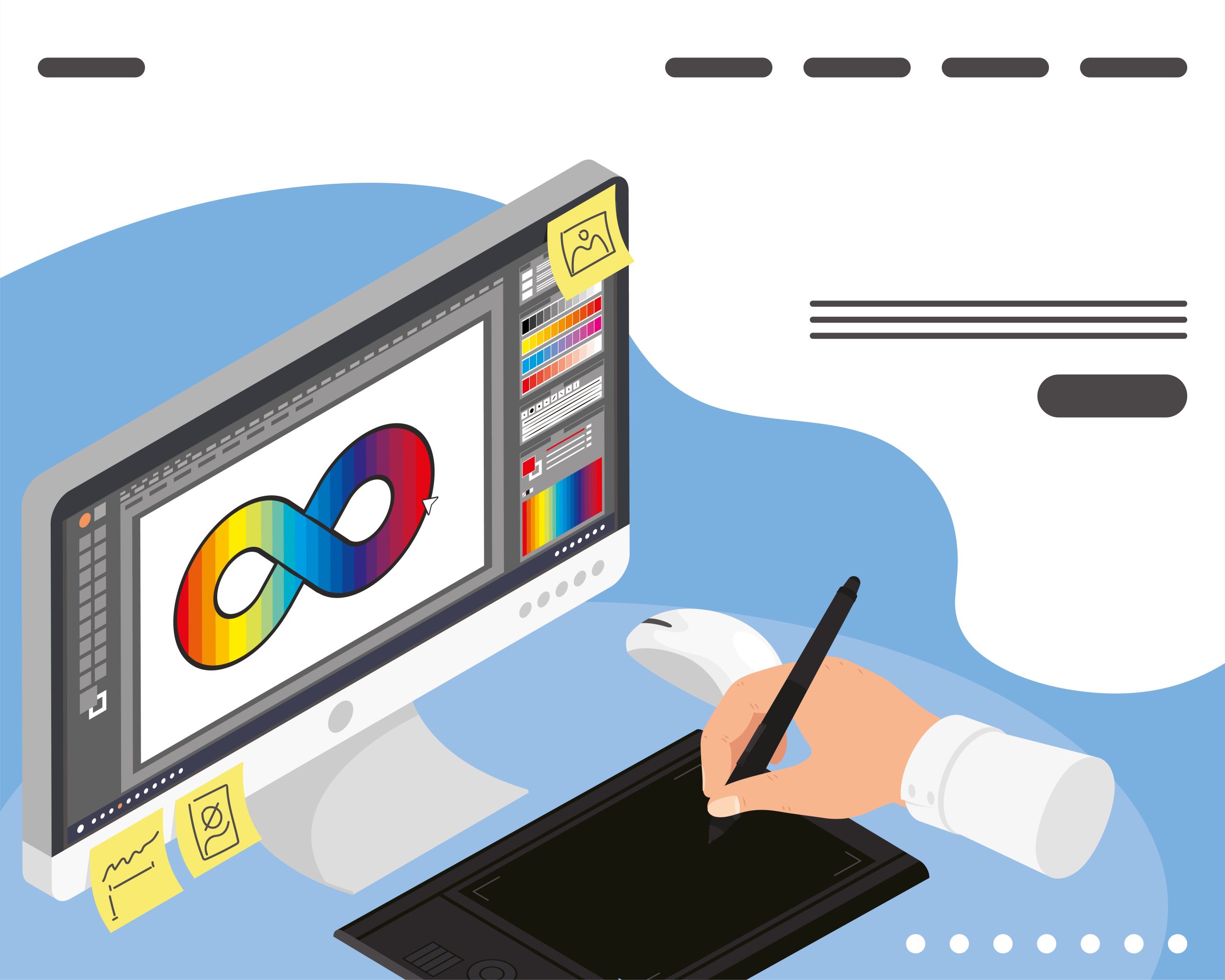If design software were tools in a craftsman’s workshop, Adobe Illustrator and Photoshop would be like a chisel and a paintbrush—each serving a unique purpose. As you weigh the merits of Illustrator versus Photoshop for your design work, consider how these digital instruments can shape your creative vision. The decision between the two can be pivotal in defining the finesse and impact of your designs. Stay tuned to uncover the nuances that distinguish these powerhouse programs and ultimately guide your design choices towards excellence.
Main Differences Between Illustrator and Photoshop
When deciding between Adobe Illustrator and Photoshop, it’s crucial to understand the main differences in their graphic formats to make an informed choice for your projects. Illustrator primarily deals with vector graphics, which are based on mathematical rules, allowing for scalability without loss of quality. On the other hand, Photoshop works with raster graphics, using pixels that can limit scalability and may result in quality loss when resized. Illustrator’s focus lies in design elements like logos, icons, and illustrations, making it ideal for projects requiring precise text placement and high scalability. Conversely, Photoshop excels in image editing capabilities such as lighting adjustments, color correction, and special effects, making it more suitable for photo manipulation and web graphics. Depending on your creative applications, Illustrator is best for creating vector-based graphics, while Photoshop is preferred for pixel-based image editing needs. Understanding these distinctions will help you choose the right tool for your specific design requirements.
Key Features of Adobe Illustrator
Understanding the key features of Adobe Illustrator is essential for harnessing its power in creating high-quality vector graphics. Adobe Illustrator is a powerhouse for graphic design, specializing in vector graphics that are ideal for print projects, logo design, and scalability. Below is a breakdown of the key features that make Adobe Illustrator a top choice for designers:
| Feature | Description | Benefits |
|---|---|---|
| Vector Graphics | Perfect for creating scalable designs without losing quality | Ideal for logos and illustrations |
| Print Projects | Ensures high-quality output suitable for printing | Great for brochures and branding |
| Scalability | Graphics maintain quality regardless of size, making them versatile for various applications | Perfect for projects with variable dimensions |
| Logo Design | Tailored tools for creating impactful and professional logos | Essential for branding and corporate identity |
Mastering these features in Adobe Illustrator can elevate your design work, providing the precision and quality necessary for successful projects.
Key Features of Adobe Photoshop
Explore the robust capabilities of Adobe Photoshop for advanced image editing and creative compositing.
- Image Editing: Adobe Photoshop is renowned for its powerful image editing tools, allowing you to enhance, retouch, and manipulate photos with precision. From adjusting colors and tones to removing imperfections, Photoshop provides a comprehensive platform for all your image editing needs.
- Creative Compositing: With Photoshop, you can seamlessly blend multiple images together to create stunning compositions. Whether you are working on a digital art piece or a photo montage, Photoshop offers advanced features like layers, masks, and blending modes for creative compositing.
- Special Effects: Unleash your creativity with Photoshop’s array of special effects tools. Add dramatic lighting effects, apply filters for unique looks, or create surreal compositions using brushes and textures. The possibilities for experimentation and artistic expression are endless.
- RAW Photos: Adobe Photoshop supports RAW photo formats, allowing you to work with high-quality images captured directly from digital cameras. Harness the full potential of your RAW photos by editing them with Photoshop’s sophisticated tools and preserving the original image quality.
- Pixel Level Control: One of the key strengths of Photoshop is its ability to provide precise control at the pixel level. Whether you are working on detailed retouching or intricate design elements, Photoshop empowers you to manipulate individual pixels, ensuring meticulous attention to detail in your work.
Pros and Cons of Using Illustrator
To further understand the capabilities of Adobe Illustrator, let’s examine the pros and cons of using this versatile design software. Illustrator offers design flexibility allowing for intricate creations through its vector advantages. The software opens up a world of creative possibilities, making it ideal for branding opportunities. One of the standout features of Illustrator is its scalability benefits, ensuring that your designs maintain quality regardless of size. This is particularly advantageous for logos, icons, and illustrations that need to be resized without losing clarity. However, there are some drawbacks to consider. The complexity of Illustrator can be challenging for beginners, requiring time to master its tools. Additionally, the software demands a powerful computer to run smoothly and often results in large file sizes. Despite these cons, Illustrator remains a top choice for professionals looking to create high-quality, scalable graphics for branding and print projects.
Pros and Cons of Using Photoshop
Consider the versatility and functionality of Adobe Photoshop when weighing the pros and cons of using this powerful image editing software.
Pros and Cons of Using Photoshop:
- Advanced Editing: Photoshop offers a comprehensive toolset for intricate photo editing, advanced layering techniques, and 3D design capabilities.
- Creative Possibilities: The software provides a wide range of creative possibilities, enabling users to explore various effects, filters, and artistic enhancements for their images.
- Industry Standard: Photoshop is the industry standard for photo editing, making it an essential tool for professionals in fields like photography, graphic design, and digital art.
- Resource Intensive: Due to its robust features and capabilities, Photoshop can be resource-intensive, requiring a powerful computer to run smoothly and handle complex projects.
- Expensive Subscription: One downside is the expensive subscription model of Photoshop, which might pose a financial challenge for some users in the long term.
When to Use Illustrator
When deciding on the appropriate design software for your projects, understanding when to utilize Adobe Illustrator can significantly impact the quality and efficiency of your graphic creations. Illustrator is best suited for tasks like logo design, where scalability and high-quality output are crucial. Its strength lies in creating vector graphics, making it ideal for print projects that require custom fonts and detailed illustrations. Whether you need to design intricate logos, craft custom typography, or create graphics with precise text placement, Illustrator’s capabilities shine through. Additionally, if your project involves freehand drawing or requires the creation of illustrations for brochures and icons, Illustrator is the go-to tool. Its ability to generate graphics that maintain quality regardless of size makes it perfect for producing visually appealing content for various print and digital mediums. Illustrator’s focus on graphic creation and its support for custom fonts ensure that your designs achieve a professional and polished look.
When to Use Photoshop
Explore how Photoshop can elevate your projects with its powerful image editing tools and versatile capabilities. When to use Photoshop:
- Photo Editing: Photoshop excels in photo editing tasks such as retouching, color correction, and enhancing images to achieve professional results.
- Digital Painting: The software offers a wide range of brushes, textures, and painting tools, making it ideal for digital painting and creating artistic compositions.
- Raster Graphics: As a raster-based program, Photoshop is perfect for working with pixel-based images, allowing for detailed editing and manipulation.
- Pixel Level Control: With Photoshop, you have precise control over individual pixels, enabling you to make intricate adjustments and fine-tune your designs with accuracy.
Incorporating Photoshop into your workflow is beneficial when working on projects that require extensive photo editing, digital painting, manipulation of raster graphics, and the need for pixel-level control and variable dimensions. This tool’s capabilities can enhance the visual appeal and quality of your designs, ensuring your projects stand out with professional polish.
Best Practices for Illustrator and Photoshop
Elevate your design projects by implementing best practices for utilizing Adobe Illustrator and Photoshop effectively, maximizing their respective strengths for optimal results. When integrating these tools into your design workflow, consider their unique advantages. Illustrator excels in graphic creation, ideal for logos, icons, and print projects due to its scalability options. Use Illustrator for intricate designs that require high-quality print output. On the other hand, Photoshop shines in image manipulation, making it perfect for editing photos and creating rasterized art for digital projects. Incorporate Photoshop for detailed shading, color gradients, and digital publications. For print projects requiring precise text placement or brochures, Illustrator is the go-to choice. Conversely, if you need to manipulate images, adjust lighting, or create web graphics, Photoshop is your best bet. Remember, both applications offer a myriad of design possibilities, so leveraging their strengths collaboratively can lead to well-rounded and visually stunning outcomes in your creative endeavors.




